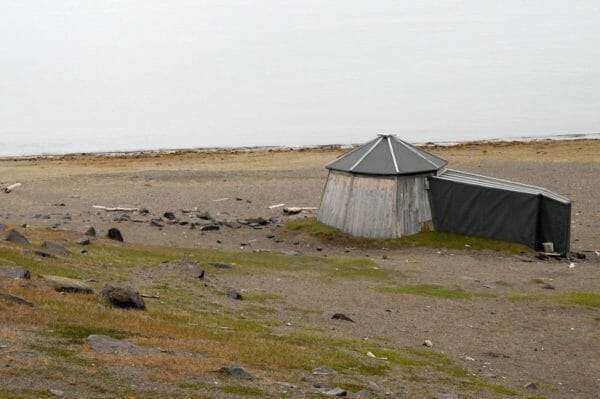
U.S.A. –-(AmmoLand.com)- On March 5, 2005, two people were attacked by a polar bear in the remote area of Kapp Lee, Edgeøya, in the Svalbard archipelago.
The .500 Smith & Wesson revolver had been on the market for just over two years when this occurred. The individual responsible for security had one of those big revolvers on his person.
This story was uncovered as part of a Freedom of Information Act (FOIA) request by AmmoLand. The names of the individuals involved were redacted. The original account is a translation with some grammatical and spelling errors.
What follows is the account, edited for readability. The names Paul and Sally have been substituted for the redacted names. This is what happened.
Paul, Sally and two more people were airlifted from Longyearbyen to Kapp Lee, Edgeøya, and landed at 2:21 PM. The helicopter flew the two other people a bit further away to install a digital camera to take pictures of Storfjorden.
Paul was responsible for the security of the research and security against polar bears.
He was very experienced with polar bears. He had numerous encounters but had never had to kill a bear. Paul and Sally had a dog with them, for additional protection against polar bears.
As the helicopter took off, Paul loaded their two weapons. He loaded the 30-06 rifle magazine with four cartridges. Then he loaded the handgun with five rounds in the magazine (cal. 50) and took out the flare pistol. (The handgun magazine almost certainly refers to the revolver cylinder, because of translation effects).
Paul had the handgun and the flare pistol. Paul and Sally both took bags/cases/material and went directly to the middle one of the three cabins of the station. There had been one trip there before them. Some material was left by the door. They dug away parts of the snowdrift in front of the door. Some of the cases were placed close to the snowdrift. Then they started the work of taking off the window shutters.

Paul had to be inside the cabin to take off the shutters. As they were doing this chore, Paul noted the dog had taken a stand, looking north of the cabin.
Paul saw a polar bear coming at a constant pace along the beach towards the cabins.
He yelled that there was a polar bear and went immediately to the cabin door and met Sally.
He loaded the signal pistol with a red signal flare. From earlier experience, he had found that red flares are just as efficient as bangers to scare bears since the red flares are red and visible the whole way, compared to the bangers that are not visible before they explode.
Paul fired two red signal flares toward the bear with no apparent effect.
The first flare was fired in front of the bear 73 meters away. The 2nd flare was fired at 54 meters away. The bear continued towards them. Paul loaded and prepared to fire a flare/banger as the bear closed to 25 meters away.
He saw the bear was too close. The flare would explode behind the bear. He fired it toward the ground in front of the bear. The flare bounced over the bear and exploded behind it. The bear did not react.
Sally was standing beside Paul with the rifle. Paul took the rifle and chambered a round. He fired 2 warning shots right after one another as the bear closed to about 11 meters over the bear’s head.
The bear did not react to the warning shots. It continued at a quick, constant pace toward them.
After the second warning shot, Paul gave Sally the rifle and commanded her into the cabin.
He went to the door but noted that only the light was from the open door. There was a lot of equipment in front of the door. Sally had managed to jump over the equipment. Paul turned around and tried to close the door. The snow made it impossible to close the door completely.
The bear was very close. Paul used the handgun to shoot two warning shots, in the air, over the bear. The dog was barking at the bear at the same time.
The bear did not stop or react to the shots or the dog.
Paul felt that the bear would get into the cabin if he did not shoot it.
He had trouble closing the door, did not know how to lock it, and did not know the inside of the cabin.
In far less time than it takes to tell it, Paul yelled, “Dammit, I’m shooting,” and fired one shot at the bear, now only 1.4 meters (five feet) away.
He tried to aim at the heart/lung areas, but was not sure where he hit, other than that it was to the right side of the neck, from the front, toward the back of the bear.
The bear turned immediately and ran away. The bear collapsed 48 meters from where Paul stood.
Paul heard the sound of the helicopter coming back. He wanted to alert the Governor.
He signaled to the helicopter. The pilots stopped the machine. Paul went up to the bear with a bamboo stick and poked it on the eyelids. It did not react and Paul understood the bear was dead.
Opinion:
Five feet is far too close to wait for a polar bear, who shows no hesitation, to close with you.
Svalbard regulations govern the minimum energy of handgun cartridges used for protection from polar bears. Maximum loaded .41 magnum and above can qualify.
About Dean Weingarten:
Dean Weingarten has been a peace officer, a military officer, was on the University of Wisconsin Pistol Team for four years, and was first certified to teach firearms safety in 1973. He taught the Arizona concealed carry course for fifteen years until the goal of Constitutional Carry was attained. He has degrees in meteorology and mining engineering, and retired from the Department of Defense after a 30 year career in Army Research, Development, Testing, and Evaluation.

from https://ift.tt/gUHkcBP
via IFTTT

No comments:
Post a Comment